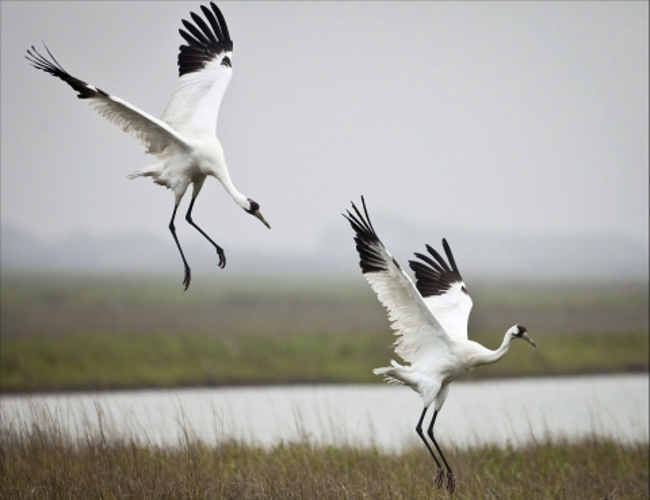You are here
Science Resources: Water and the Law
Why Is an Understanding of Drought Important? A Legal Perspective
In many parts of the United States, disputes over groundwater and surface water management are a significant part of natural resources and takings law. Disputes regarding the use of water between agriculture, industry, cities, and the environment are common, particularly in the arid West where much of the nation’s irrigated land is concentrated [1]. Changes in the patterns of water demand and supply will continue to shift the legal and regulatory discourse around water.
Scientists predict changes in precipitation patterns across the country, including changes in the amount of precipitation that falls (more or less), the timing of the precipitation (winter versus summer), or the type of precipitation (rain versus snow). While some areas of the country may see an increase in precipitation, increased aridification is predicted for major areas of the western United States [2]. Decreases in precipitation, as well as changing precipitation patterns, exacerbate water conflicts, particularly in the West where agriculture constitutes as much as 70 percent of the water use of major river basins [3].
Although private rights to use water use are governed by state law, federal intervention is common due to water demands associated with maintaining environmental habitat under the Endangered Species Act (ESA), trust obligations to tribal nations that entail the realization and protection of reserved water rights, and interstate water conflicts. At their core, federal interventions in these areas stem from water scarcity. For example, in California’s Central Valley Project, a water resources development project managed by the federal Bureau of Reclamation, decisions over how and where to allocate water use between environmental and agricultural uses have led to conflict in the federal courts (Stock East Water Dist. v. United States, 2011).
Statutes such as the ESA highlight the importance of drought science in understanding broader legal disputes over water rights. When beneficial uses require an increasing proportion of available water, allocations for in-stream uses such as recreation and ecological protection are often controversial. In 2014, The Arkansas Project sued the Texas Commission on Environmental Quality (TCEQ), saying that the agency’s regulatory practices had diverted so much water from the San Antonio and Guadalupe rivers that TCEQ had adversely impacted populations of endangered whooping crane nesting in the downstream San Antonio Bay (see Arkansas Project v. Shaw, 2014). In 2015, at the height of the California drought, the decision to maintain millions of gallons of water in rivers for species such as the endangered Delta smelt engendered widespread condemnation amongst farmers’ advocacy groups [4].
Throughout the West, the federal government has been and remains extensively involved in Indian water rights settlements [5]. In Winters v. United States (1908), the court ruled that when the federal government created Indian reservations, it implicitly reserved the rights to an amount of water sufficient to fulfill the purposes of the reservation. Determination of these rights is particularly controversial and difficult in arid and drought-stricken areas.
The U.S. Supreme Court has intervened several times as a court of original jurisdiction for inter-state water rights disputes, most recently in 2021 (see Mississippi v. Tennessee).
Drought also impacts federal cases brought under the Clean Water Act (CWA). Per the ruling in PUD No. 1 v. Washington Dept. of Ecology (1994), minimum flows in streams can constitute a requirement under a state’s Total Maximum Daily Load (TMDL) standards. Significantly reducing the volume of water in streams can also adversely impact the concentration of contaminants of concern in streams and rivers, potentially bringing them into violation of water quality-based TMDLs [6].
[1] U.S. Department of Agriculture Economic Research Service, "Irrigation and Water Use," May 6, 2022. [Online]. Available: https://www.ers.usda.gov/topics/farm-practices-management/irrigation-water-use/. [Accessed June 30, 2022].
[2] J. Overpeck and B. Udall, “Climate change and the aridification of North America,” PNAS, vol. 117, no. 22, pp. 11856–11858, 2021.
[3] Bureau of Reclamation, “Colorado River Basin: SECURE Water Act Section 9503(c) Report to Congress,” U.S. Department of Interior, Washington, D.C., 2021.
[4] S. Smith, “Farmers in dry California decry decision involving appeals (Update),” Phys.org News, 12 Jan 2015.
[5] Congressional Research Service, “Indian Water Rights,” CRS, Washington, D.C., 2016. Note: Indian Water Rights Settlements, Congressional Research Service, 2023 https://crsreports.congress.gov/product/pdf/R/R44148.
[6] R. Percival, C. Schroeder, A. Miller and J. Leape, Environmental Regulation: Law, Science, and Policy, 9th ed., Boston, MA: Aspen Publishing, 2021.


